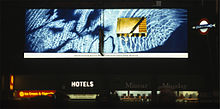- Collett Dickenson Pearce
-
Collett Dickenson Pearce & Partners (CDP) emerged from the "Swinging London" cultural shifts of the 1960s as Britain's most glamorous and influential advertising agency, generally regarded as one of the finest advertising agencies in the world during the 1970s. Launched in April 1960, it was a nursery for the careers of many who were to become internationally famous; among those working there as young men were Frank Lowe (now Sir Frank Lowe), David Puttnam (now Lord Puttnam), Alan Parker (now Sir Alan Parker), John Hegarty, Indra Sinha, Neil Godfrey, and Charles Saatchi. Ridley Scott, the director of Blade Runner, Alien and Gladiator, made commercials for CDP, as did Chariots of Fire director Hugh Hudson. The creative director during the first two key decades was the late Colin Millward, a dour veteran of World War II.[1]
Puttnam's role was as an account executive. "My equivalent of university was the five years [1962-1967] I spent working at an advertising agency called Collett Dickenson Pearce ... with good reason I believed I was working for the best agency in the world. Most of the work we were doing was both different and good; and we were winning awards and gaining recognition left, right and centre."[2]
The agency's output had a distinctive sharp wit and confident font-led graphic style, well suited to the voguish "colour supplements" which the Sunday newspapers were launching at this time. By the 70s, colour television with improved picture definition was rapidly taking root, bringing the need and the opportunity for greater sophistication in the commercials it showed. CDP plunged in under its new managing director Frank Lowe (later Sir Frank), and set the tone for what is now viewed as a golden creative period in British advertising. Clients included Harvey’s Bristol Cream, Bird’s Eye, Parker pens, Fiat, Ford, Acrilan, Pretty Polly and Ronson. Campaign slogans which entered the national consciousness include "Happiness is a cigar called Hamlet" and "Land Rover. The best 4 x 4 x far." "Heineken refreshes the parts other beers cannot reach" (1974). ( 1979 ) Heineken Galley Slave commercial http://www.youtube.com/watch?v=eWXWND4hKzA These, and commercials for Hovis (by Ridley Scott, 1973) and Cinzano (Alan Parker, 1978), all appear in the upper reaches of 100 Greatest TV Ads
The agency's most notorious campaign was for Benson & Hedges cigarettes – carried principally on posters and in print, because cigarette advertising had been banned from British television since 1965. To circumvent restrictions on associating smoking with youth, glamour or life style, CDP devised a memorable series of images placing the product's gold pack in highly contrived, surreal surroundings. No people were shown, and not a word of copy, apart from the obligatory Government health warnings.
After years of dwindling fortune in the late 1980s and through the 1990s, Collett Dickenson Pearce finally ceased business in 2000. The company was acquired by the Dentsu group, the fifth largest global marketing communications group, which then incorporated the famous name into an existing agency Travis Sully, which was renamed CDP-Travissully London.
References
- ^ Obituary in London Times, 1 June 2004
- ^ Account of his time at CDP in Speech by Lord Puttnam of Queensgate CBE to London Metropolitan University Honorary Degree Holders Dinner, 10 March 2004, pp 3-7
See also
- The Men From the Agency BBC Four documentary examining the influence of CDP.
- Authors, John Salmon and John Ritchie. (2001). Inside Collett Dickenson Pearce, London: Batsford. ISBN 0713484039
Categories:- Cultural history of the United Kingdom
- Advertising agencies of the United Kingdom
- 1960s in the United Kingdom
- 1970s in the United Kingdom
Wikimedia Foundation. 2010.

